Development and Test of Geogrid with Distributed Deformation Monitoring Function
Abstract
1. Introduction
2. Resistance Sensitive Performance Test of Geogrid
2.1. Material and Fabrication of Specimen
2.2. Experiment Procedure
3. Experimental Results Analysis
3.1. Variation Rules of Resistance Values
3.2. Locating Deformation Position by the Variation of Resistance Values
- (1)
- Points on the edge. Since each point on the edge of the metal frame involves the deformation of only one rib, the resistance change value on the corresponding rib is applied here.
- (2)
- Corner points. At the four corner points, although no rib is installed here in this experiment, according to the analysis in the previous section, that is, the farther away the rib resistance is from the stress point, the smaller the change in the resistance will be. The distance between the four corner points and the stress point must be greater than the distance between the two adjacent edge points and the stress point, so the smaller change in the resistance of the two adjacent edge points can be used to simply replace the actual value at the corner point.
3.3. Effect of Loading Position on Variation of Electrical Resistance
4. Simulation and Analysis
4.1. Setup of Numerical Simulation
4.2. Stress Variation of Geogrid Model
4.3. Stress Distribution on Geogrid
5. Conclusions
- Through the analysis and comparison of the results of the points at the crossing of horizontal and longitudinal ribs, it can be found that when the point is loaded, the resistance value change of the two ribs passing through the loading point is significantly higher than that of other ribs. Moreover, in the same direction (horizontal or longitudinal) of the ribs, the closer the rib is to the loading point, the greater the resistance change is, and the farther the rib is from the loading point, the smaller the resistance change is.
- The resistance distribution of geogrid plane can be obtained by superimposing the resistance changes of the ribs in the horizontal and longitudinal directions of the loading points. According to the size of the resistance change, the position of the deformation in the rock mass and the size of the settlement displacement can be preliminarily determined.
- By analyzing the resistance variation of each rib separately, during the loading–unloading process, it can be seen that resistance value increases during loading and decreases during unloading.
- Through the analysis of the test results of the same load on the loading points in different positions, the peak resistance changes caused by the load on the loading points in different positions are different. The peak resistance changes near the fixed end are larger, while the peak resistance changes near the center are smaller.
- The closer the loading point to the center position is to the external force, the greater the range of resistance changes, and the greater the possibility of being monitored. On the contrary, the closer the loading point to the boundary of the geogrid is to the external force, the smaller the range of resistance changes. Therefore, in practical engineering applications, the center position of the geogrid is suggested to be laid in the key monitoring area.
- By comparing the plane stress distribution of geogrid after being stressed by numerical simulation with the plane resistance distribution measured by experiment, it can be concluded that reversing the deformation of the geogrid by using the variation of the resistance value of each rib is feasible.
Author Contributions
Funding
Institutional Review Board Statement
Informed Consent Statement
Data Availability Statement
Conflicts of Interest
References
- Kazimierowicz-Frankowska, K. Influence of geosynthetic reinforcement on the load-settlement characteristics of two-layer subgrade. Geotext. Geomembr. 2007, 25, 366–376. [Google Scholar] [CrossRef]
- Latha, G.M.; Murthy, V.S. Effects of reinforcement form on the behavior of geosynthetic reinforced sand. Geotext. Geomembr. 2007, 25, 23–32. [Google Scholar] [CrossRef]
- El Sawwaf, M.A. Behavior of strip footing on geogrid-reinforced sand over a soft clay slope. Geotext. Geomembr. 2007, 25, 50–60. [Google Scholar] [CrossRef]
- Zhou, H.; Wen, X. Model studies on geogrid- or geocell-reinforced sand cushion on soft soil. Geotext. Geomembr. 2008, 26, 231–238. [Google Scholar] [CrossRef]
- Gnanendran, C.T.; Selvadurai, A.P.S. Strain measurement and interpretation of stabilising force in geogrid reinforcement. Geotext. Geomembr. 2001, 19, 177–194. [Google Scholar] [CrossRef]
- Rowe, R.K.; Gnanendran, C.T. Geotextile strain in a full scale reinforced test embankment. Geotext. Geomembr. 1994, 13, 781–806. [Google Scholar] [CrossRef]
- Viswanadham, B.V.; König, D. Studies on scaling and instrumentation of a geogrid. Geotext. Geomembr. 2004, 22, 307–328. [Google Scholar] [CrossRef]
- Warren, K.A.; Christopher, B.; Howard, I.L. Geosynthetic strain gage installation procedures and alternative strain measurement methods for roadway applications. Geosynth. Int. 2010, 17, 403–430. [Google Scholar] [CrossRef]
- Yazdani, H.; Hatami, K. Sensor-Enabled Geogrids for Stabilization and Performance Monitoring of Earth Structures: State of Development. Int. J. Geosynth. Ground Eng. 2016, 2, 37. [Google Scholar] [CrossRef]
- Wang, Z.; Wang, J.; Sui, Q.; Li, S.; Jia, L. In-situ calibrated deformation reconstruction method for fiber Bragg grating embedded smart Geogrid. Sens. Actuators A Phys. 2016, 250, 145–158. [Google Scholar] [CrossRef]
- Diaz, S.; Foaleng Mafang, S.; Lopez-Amo, M.; Thevenaz, L. A High-Performance Optical Time-Domain Brillouin Distributed Fiber Sensor. IEEE Sens. J. 2008, 8, 1268–1272. [Google Scholar] [CrossRef]
- Wang, B.; Li, K.; Shi, B.; Wei, G. Test on application of distributed fiber optic sensing technique into soil slope monitoring. Landslides 2009, 6, 61–68. [Google Scholar] [CrossRef]
- Bhuvaneswari, M.S.; Vijayakumari, S.G. Health Monitoring of Civil Structures using Fiber Optic Sensors. Indian J. Sci. Technol. 2016, 9, 1–6. [Google Scholar] [CrossRef]
- Wang, K.; Zhang, S.; Chen, J.; Teng, P.; Wei, F.; Chen, Q. A Laboratory Experimental Study: An FBG-PVC Tube Integrated Device for Monitoring the Slip Surface of Landslides. Sensors 2017, 17, 2486. [Google Scholar] [CrossRef] [PubMed]
- Sun, Y.; Xu, H.; Gu, P.; Hu, W. Application of FBG Sensing Technology in Stability Analysis of Geogrid-Reinforced Slope. Sensors 2017, 17, 597. [Google Scholar] [CrossRef]
- Wang, Z.; Wang, J.; Sui, Q.; Liang, X.; Jia, L.; Li, S.; Lu, S. Development and Application of Smart Geogrid Embedded with Fiber Bragg Grating Sensors. J. Sens. 2015, 2015, 108209. [Google Scholar] [CrossRef]
- Wang, Z.; Wang, J.; Sui, Q.; Jia, L.; Li, S.; Liang, X.; Lu, S. Deformation reconstruction of a smart Geogrid embedded with fiber Bragg grating sensors. Meas. Sci. Technol. 2015, 26, 125202. [Google Scholar] [CrossRef]
- Appajaiah, A.; Wachtendorf, V.; Daum, W. Climatic exposure of polymer optical fibers: Thermooxidative stability characterization by chemiluminescence. J. Appl. Polym. Sci. 2007, 103, 1593–1601. [Google Scholar] [CrossRef]
- Husdi, I.R.; Nakamura, K.; Ueha, S. Sensing characteristics of plastic optical fibres measured by optical time-domain reflectometry. Meas. Sci. Technol. 2004, 15, 1553–1559. [Google Scholar] [CrossRef]
- Liehr, S.; Lenke, P.; Krebber, K.; Seeger, M.; Thiele, E.; Metschies, H.; Gebreselassie, B.; Münich, J.C.; Stempniewski, L. Distributed strain measurement with polymer optical fibers integrated into multifunctional geotextiles. In Optical Sensors; Berghmans, F., Mignani, A.G., Cutolo, A., Meyrueis, P.P., Pearsall, T.P., Eds.; SPIE: Bellingham, WA, USA, 2008; p. 700302. [Google Scholar]
- Silva-López, M.; Fender, A.; MacPherson, W.N.; Barton, J.S.; Jones, J.D.C.; Zhao, D.; Dobb, H.; Webb, D.J.; Zhang, L.; Bennion, I. Strain and temperature sensitivity of a single-mode polymer optical fiber. Opt. Lett. 2005, 30, 3129. [Google Scholar] [CrossRef]
- Diani, J.; Gall, K.; Liu, Y. Finite Strain 3D Thermoviscoelastic Constitutive Model. Polym. Eng. Sci. 2006, 46, 486–492. [Google Scholar] [CrossRef]
- Knite, M.; Teteris, V.; Kiploka, A.; Klemenoks, I. Reversible tenso-resistance and piezo-resistance effects in conductive polymer-carbon nanocomposites. Adv. Eng. Mater. 2004, 6, 742–746. [Google Scholar] [CrossRef]
- Yazdani, H.; Hatami, K.; Khosravi, E.; Harper, K.; Grady, B.P. Strain-sensitive conductivity of carbon black-filled PVC composites subjected to cyclic loading. Carbon 2014, 79, 393–405. [Google Scholar] [CrossRef]
- Yazdani, H.; Smith, B.E.; Hatami, K. Multi-walled carbon nanotube-filled polyvinyl chloride composites: Influence of processing method on dispersion quality, electrical conductivity and mechanical properties. Compos. Part A Appl. Sci. Manuf. 2016, 82, 65–77. [Google Scholar] [CrossRef]
- Hatami, K.; Grady, B.P.; Ulmer, M.C. Sensor-Enabled Geosynthetics: Use of Conducting Carbon Networks as Geosynthetic Sensors. J. Geotech. Geoenvironmental Eng. 2009, 135, 863–874. [Google Scholar] [CrossRef]
- Huang, J.-C. Carbon black filled conducting polymers and polymer blends. Adv. Polym. Technol. 2002, 21, 299–313. [Google Scholar] [CrossRef]
- Das, N.C.; Chaki, T.K.; Khastgir, D. Effect of axial stretching on electrical resistivity of short carbon fibre and carbon black filled conductive rubber composites. Polym. Int. 2002, 51, 156–163. [Google Scholar] [CrossRef]
- Yazdani, H.; Smith, B.E.; Hatami, K. Electrical conductivity and mechanical performance of multiwalled CNT-filled polyvinyl chloride composites subjected to tensile load. J. Appl. Polym. Sci. 2016, 133, 1–12. [Google Scholar] [CrossRef]
- Hatami, K.; Hassanikhah, A.; Yazdani, H.; Grady, B.P. Tensoresistive PVC Coating for Sensor-Enabled Geogrids. J. Nanomechanics Micromechanics 2014, 4, 1–15. [Google Scholar] [CrossRef]
- Cui, X.-Z.; Cui, S.-Q.; Jin, Q.; Wang, Y.-L.; Zhang, L.; Wang, Z.-X. Laboratory tests on the engineering properties of sensor-enabled geobelts (SEGB). Geotext. Geomembr. 2018, 46, 66–76. [Google Scholar] [CrossRef]
- Cui, X.-Z.; Cui, S.-Q.; Lu, T.; Zhang, L.; Wang, Y.-L.; Li, J. Evaluation of the performance of sensor-enabled geobelts after cyclic loading. Constr. Build. Mater. 2018, 185, 414–422. [Google Scholar] [CrossRef]
- Li, J.; Cui, X.-Z.; Jin, Q.; Su, J.-W.; Cui, S.-Q.; Wang, Y.-L. Laboratory investigation of the durability of a new smart geosynthetic material. Constr. Build. Mater. 2018, 169, 28–33. [Google Scholar] [CrossRef]
- Zhang, J.; She, R.; Xia, S.; Dai, Z.; Hu, N.; Cui, X.; Han, R.; Ming, R.; Ma, G. Development and laboratory evaluation of a self-monitoring polymer geobelts. Meas. J. Int. Meas. Confed. 2020, 166, 108214. [Google Scholar] [CrossRef]



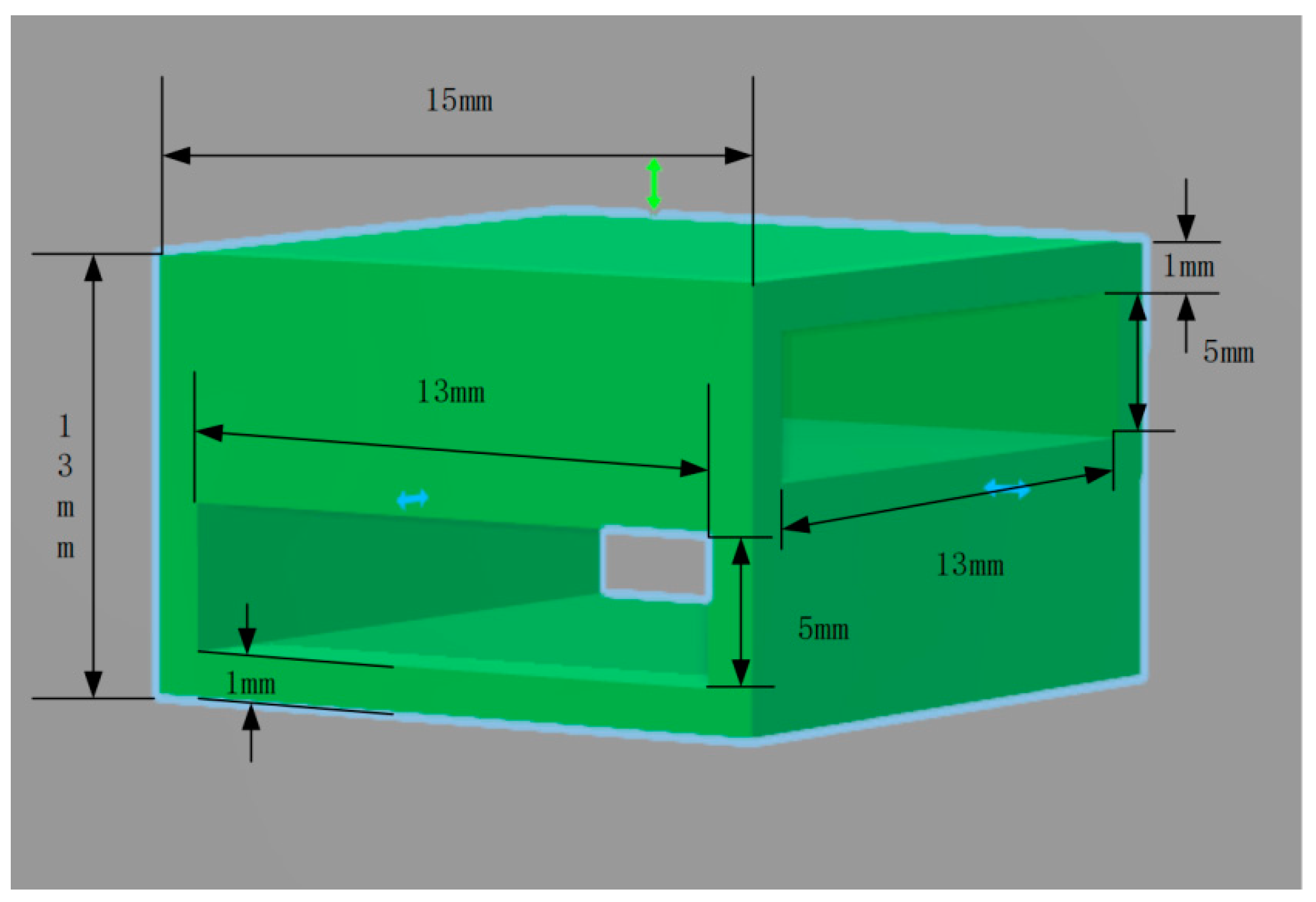
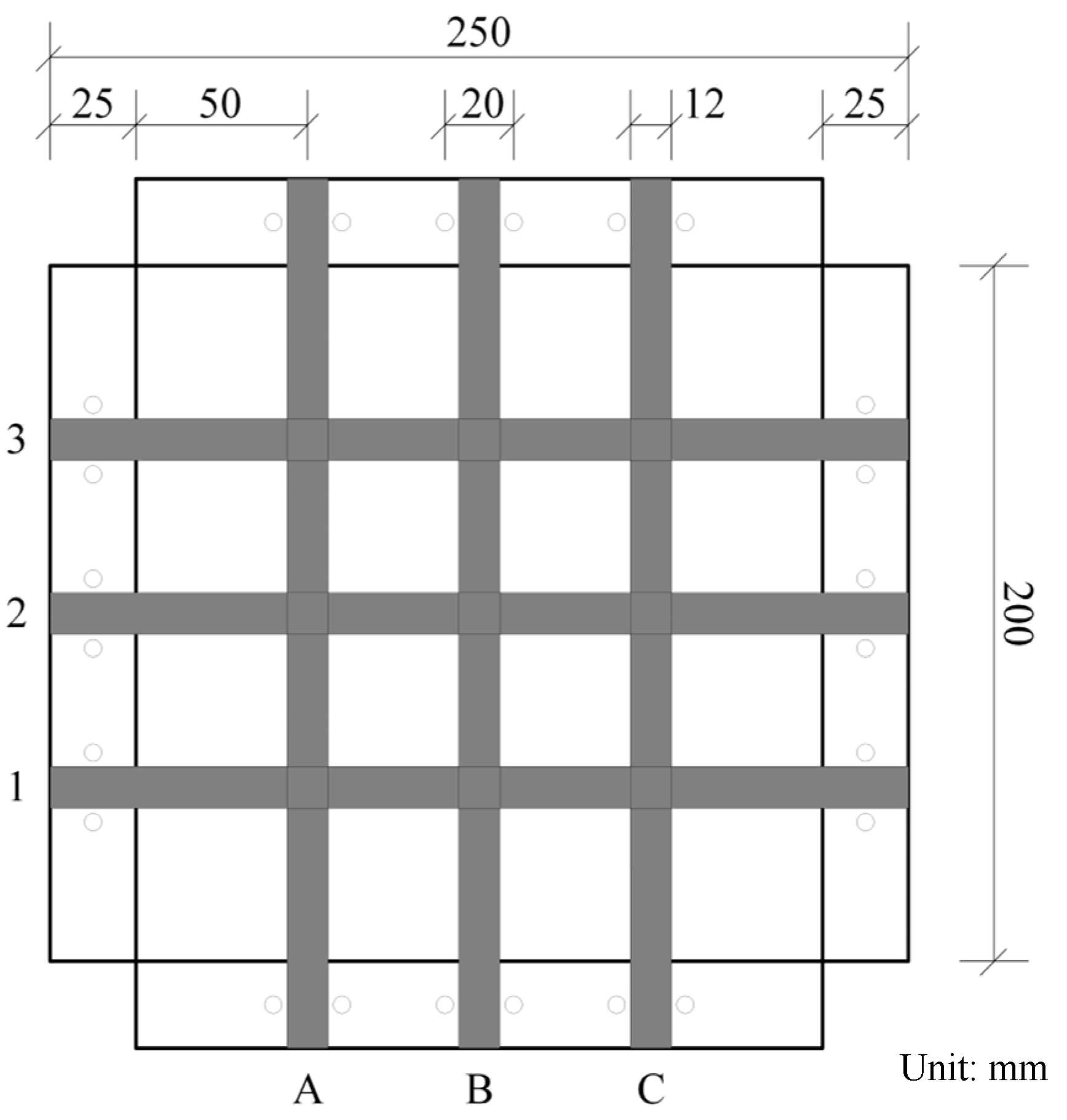
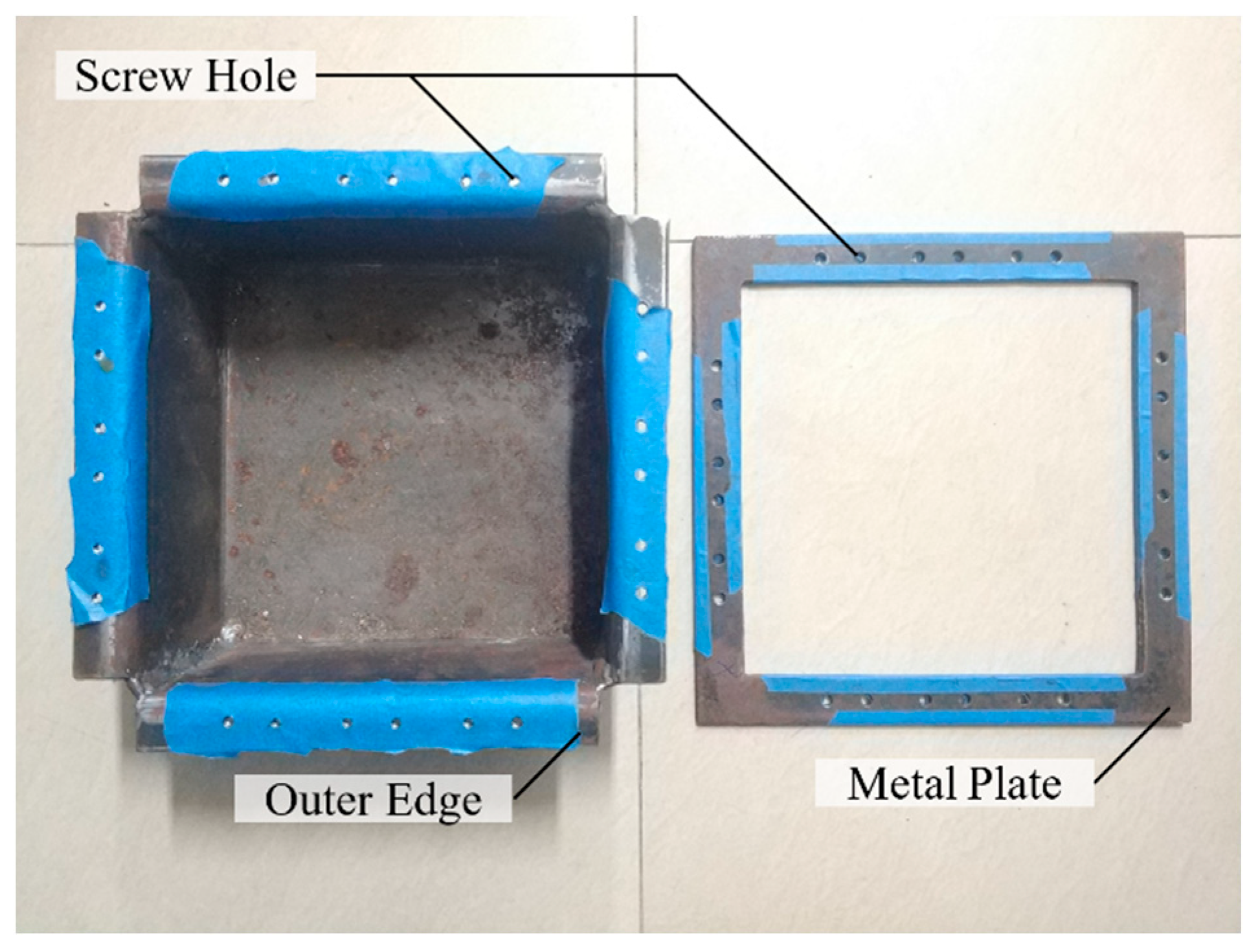
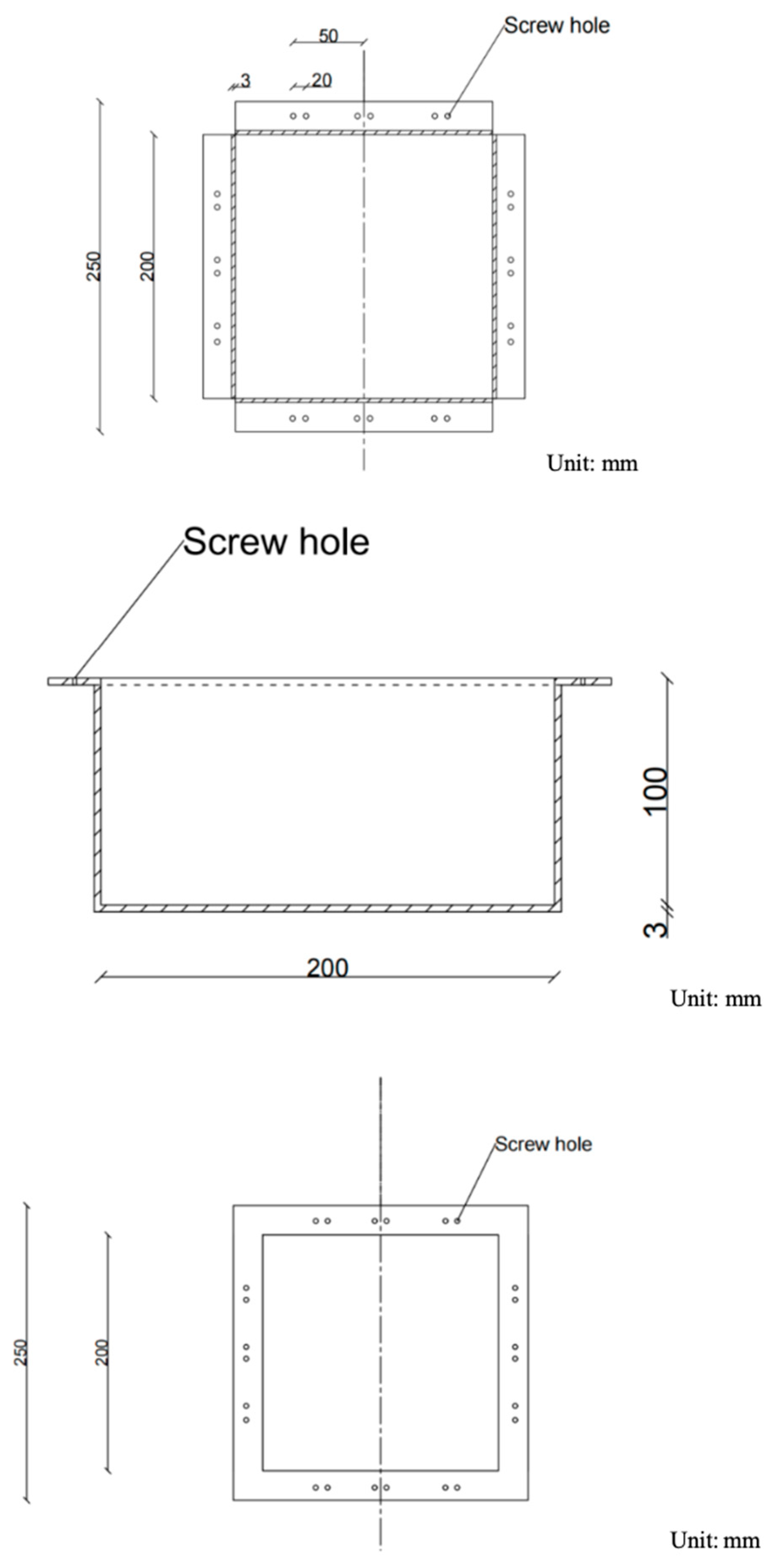
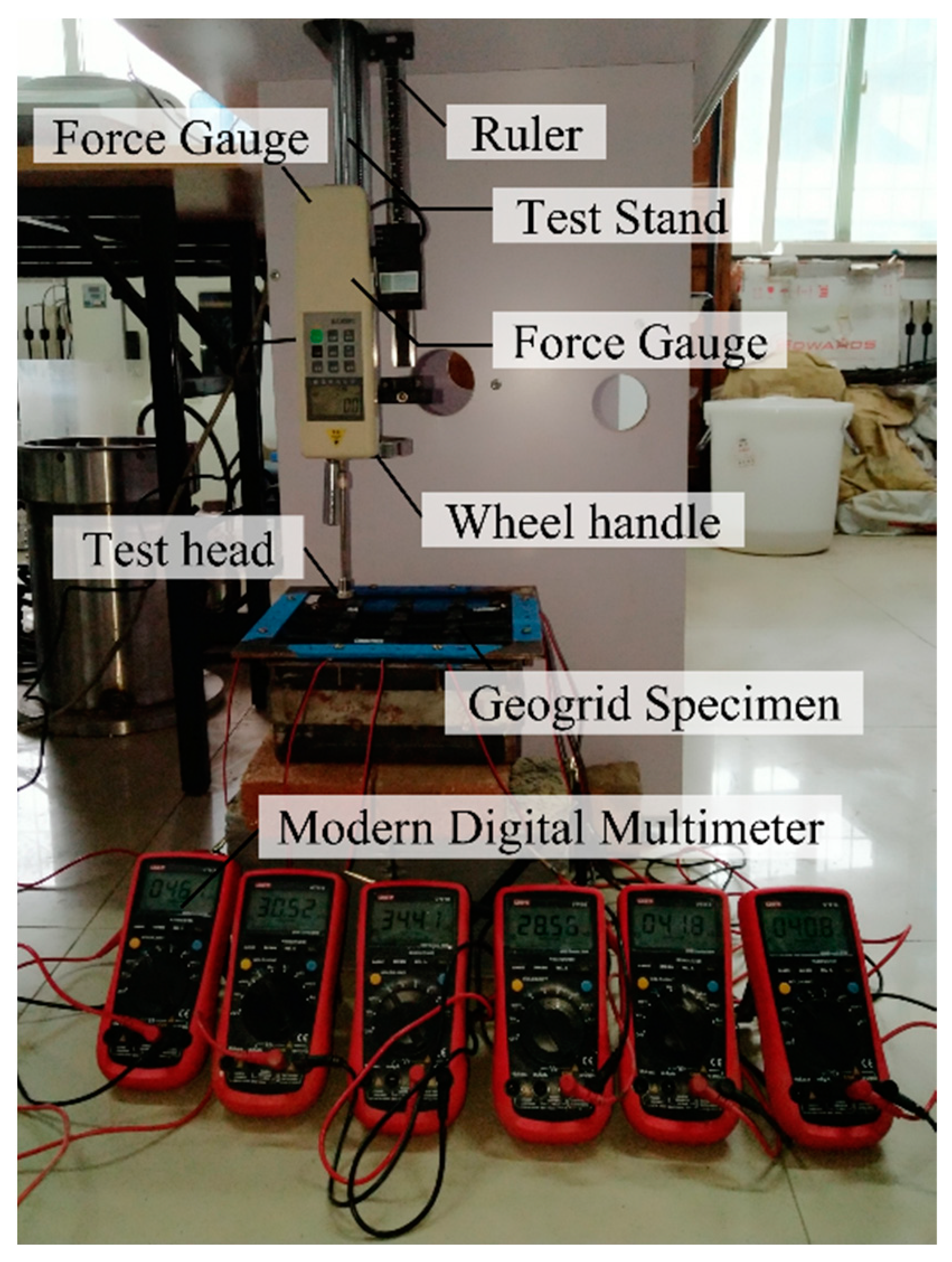

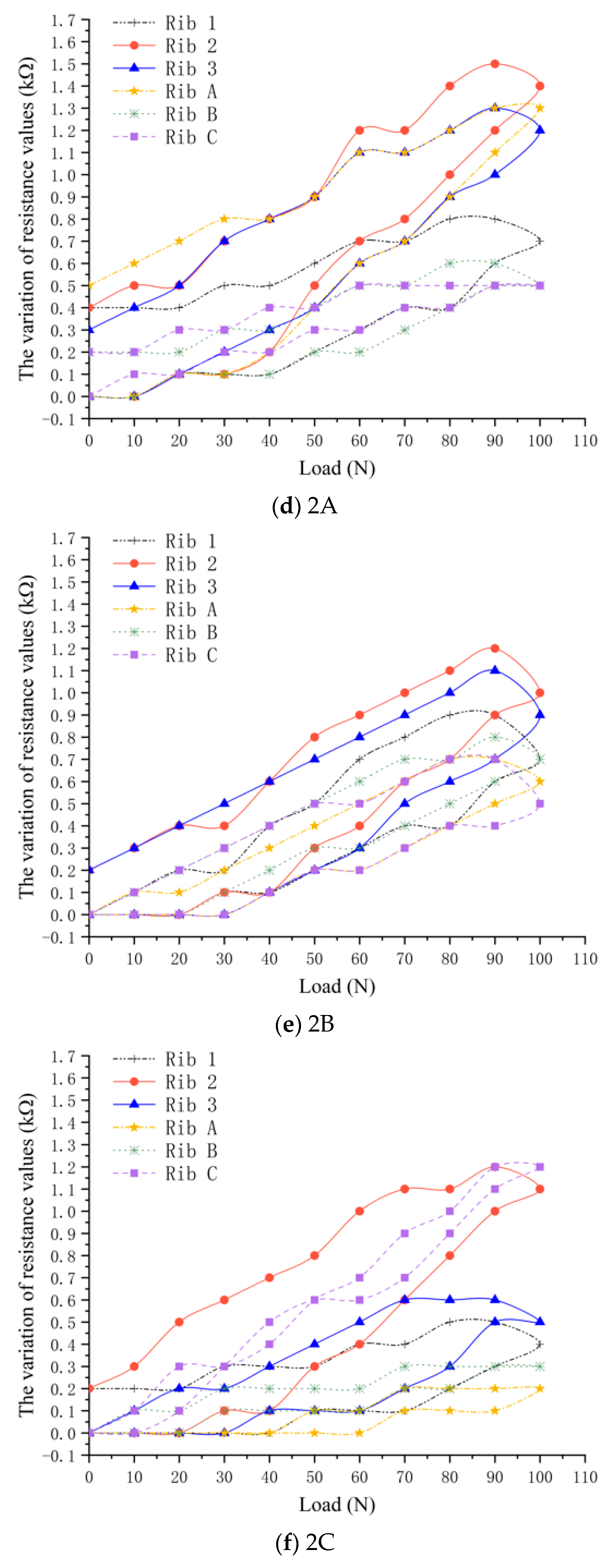
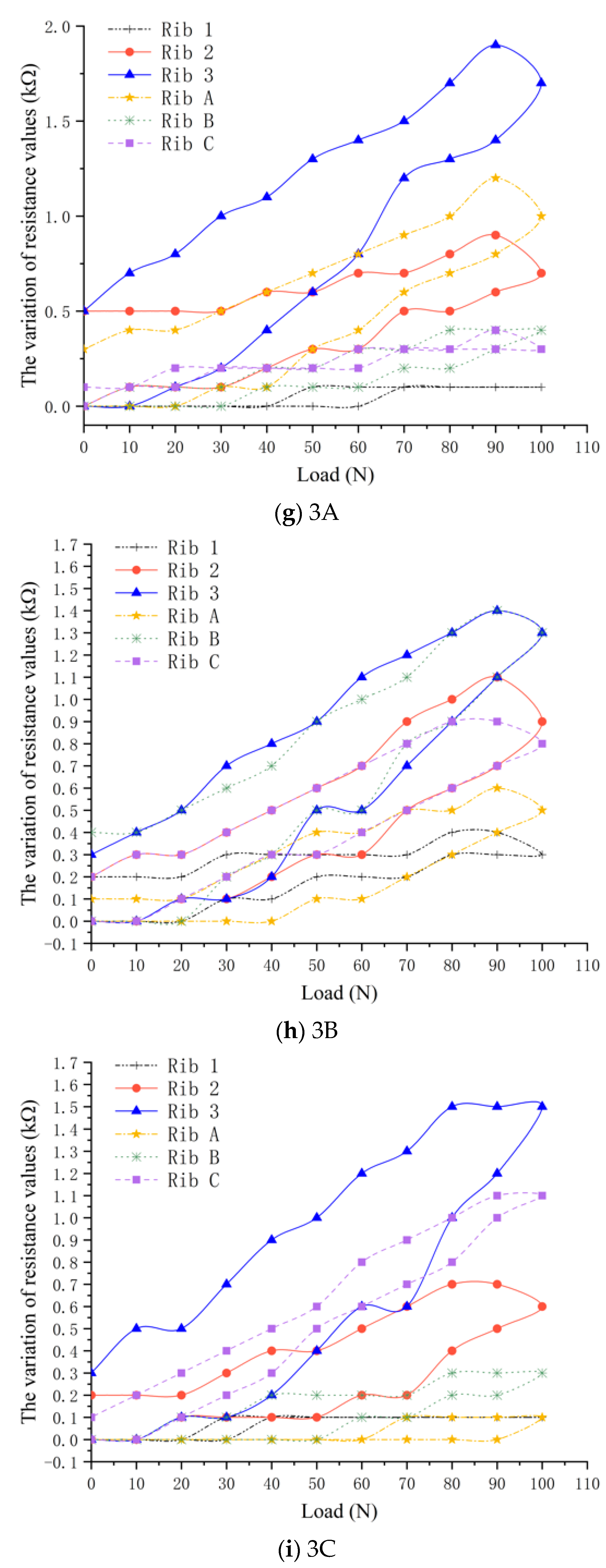
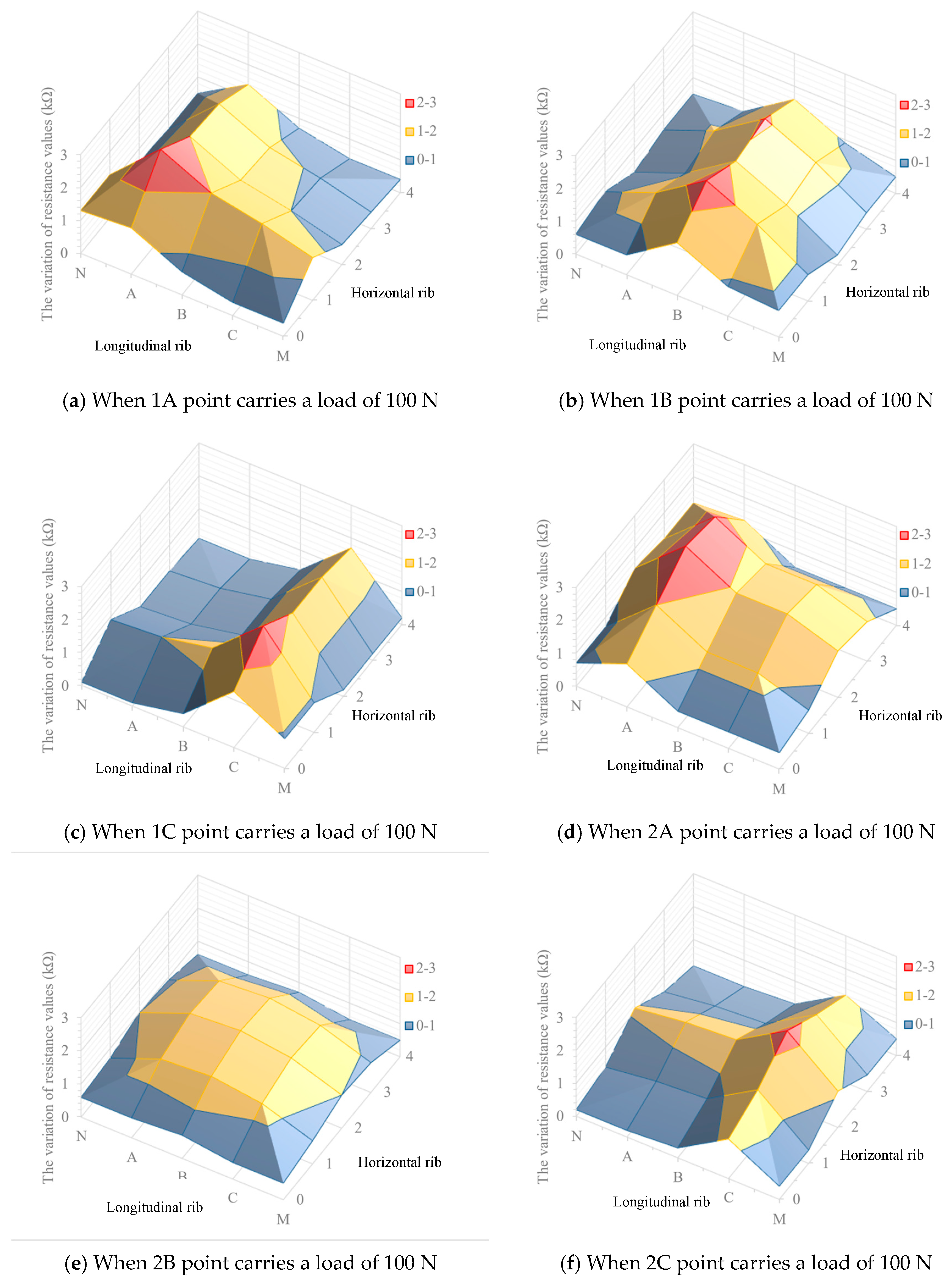

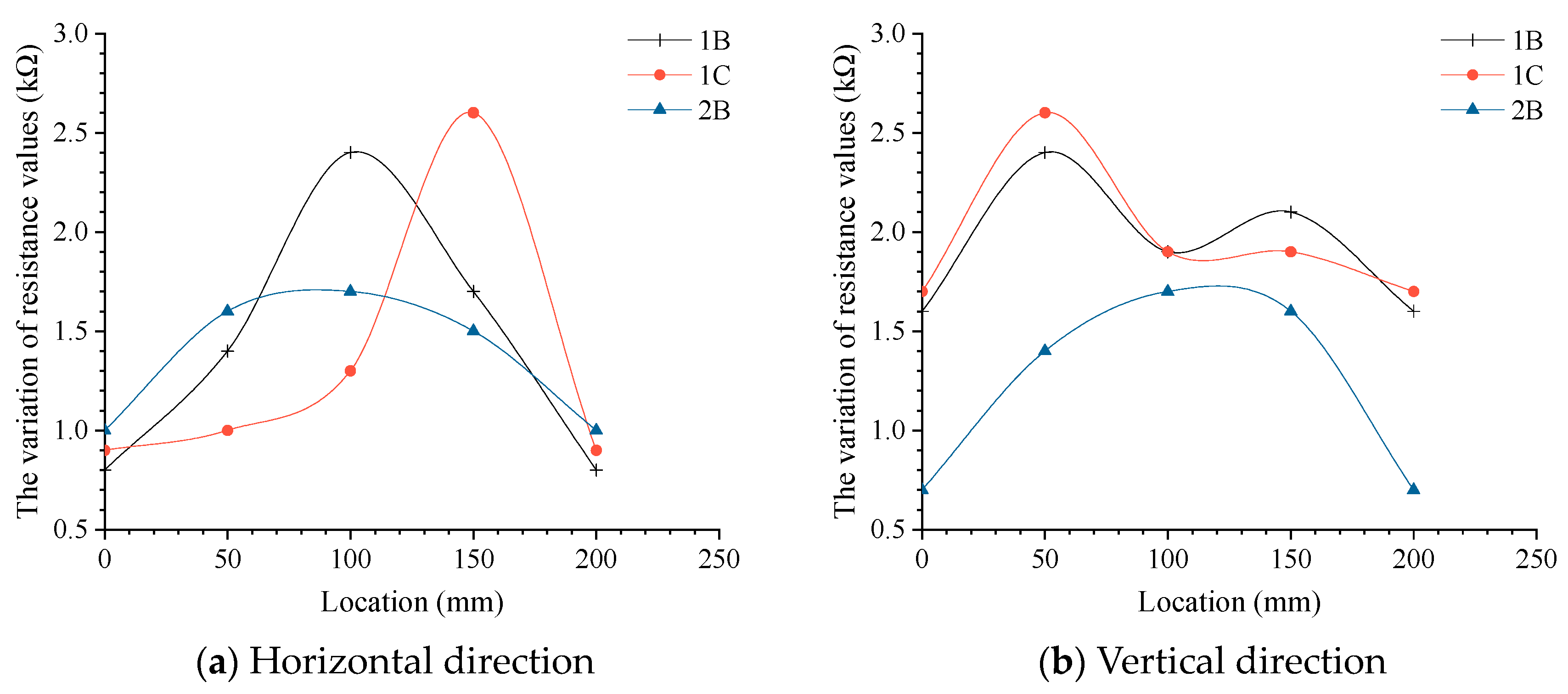

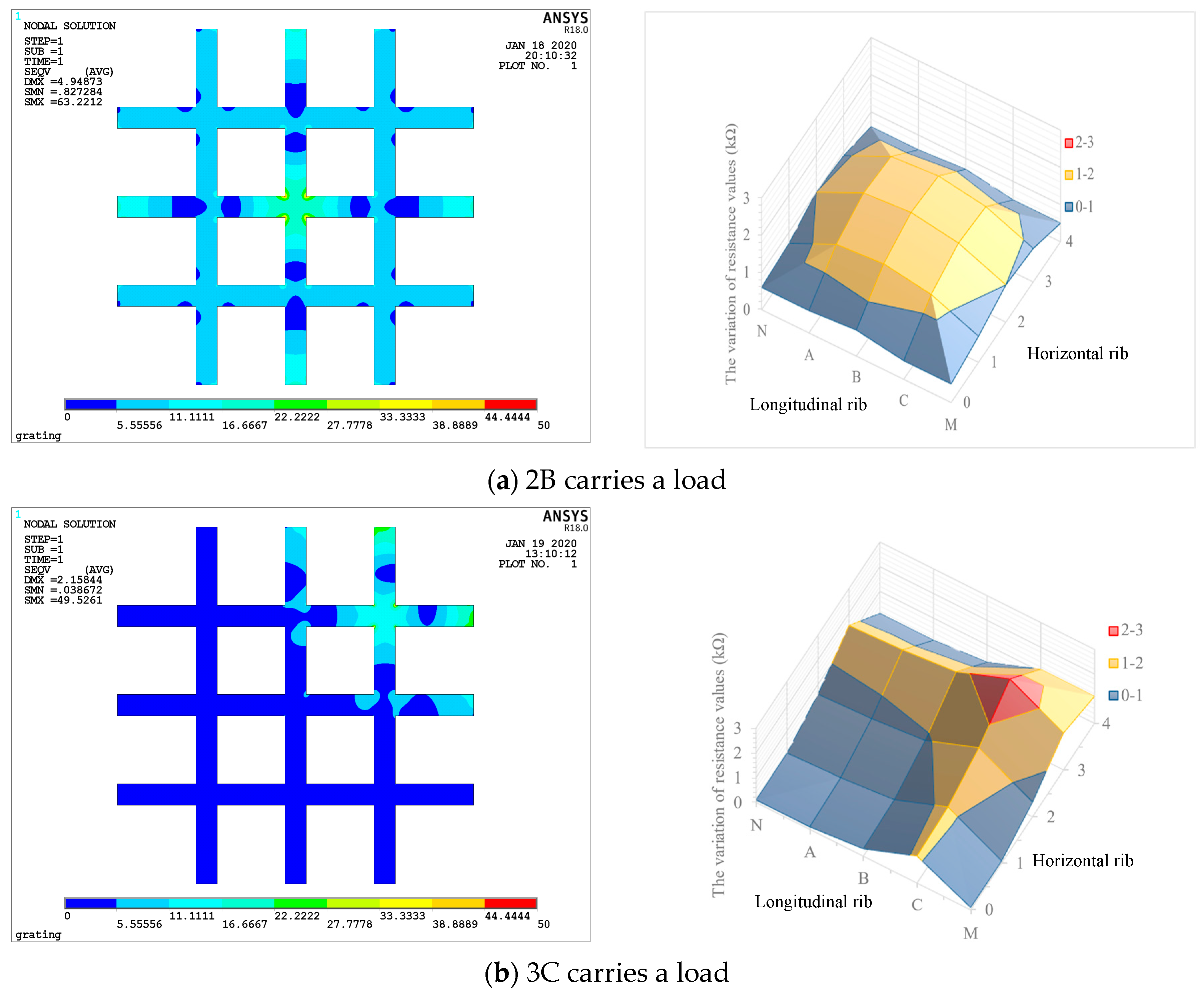
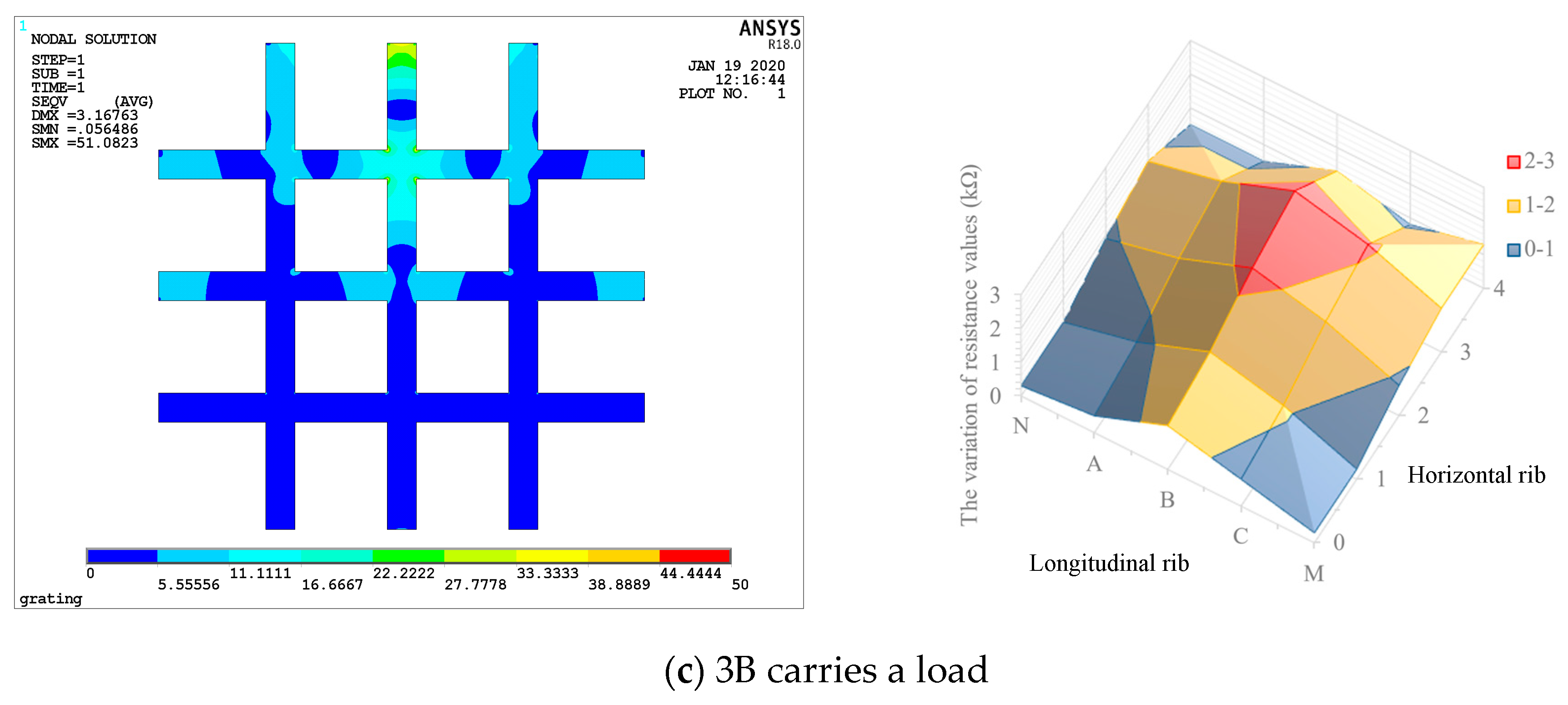
| Material | Density (kg/m3) | Tensile strength (MPa) | Elongation at Break (%) |
|---|---|---|---|
| PLA | 1.24 | 50 ± 1.3 | 2.0 ± 0.4 |
| Load (N) | 2B | 3A | 3B | |||
|---|---|---|---|---|---|---|
| Displacement (mm) | The Variation of Resistance Values (kΩ) | Displacement (mm) | The Variation of Resistance Values (kΩ) | Displacement (mm) | The Variation of Resistance Values (kΩ) | |
| 0 | 0 | 0 | 0 | 0 | 0 | 0 |
| 10 | 1 | 0 | 2 | 0 | 0.5 | 0 |
| 20 | 2 | 0 | 3 | 0.05 | 1 | 0.05 |
| 30 | 3.5 | 0.1 | 3.5 | 0.15 | 2 | 0.15 |
| 40 | 4.5 | 0.15 | 4 | 0.25 | 3 | 0.25 |
| 50 | 6 | 0.3 | 5 | 0.45 | 4 | 0.5 |
| 60 | 7 | 0.35 | 6 | 0.6 | 5 | 0.5 |
| 70 | 8 | 0.5 | 6.5 | 0.9 | 6 | 0.75 |
| 80 | 9 | 0.6 | 7 | 1 | 7 | 0.9 |
| 90 | 10 | 0.75 | 8 | 1.1 | 7.5 | 1.1 |
| 100 | 11 | 0.85 | 8.5 | 1.35 | 8 | 1.3 |
| 90 | 11 | 1 | 8 | 1.55 | 8 | 1.4 |
| 80 | 10 | 0.9 | 8 | 1.35 | 7.5 | 1.3 |
| 70 | 9.5 | 0.85 | 7 | 1.2 | 7 | 1.15 |
| 60 | 9 | 0.75 | 7 | 1.1 | 6 | 1.05 |
| 50 | 7.5 | 0.65 | 6 | 1 | 5 | 0.9 |
| 40 | 6 | 0.5 | 5 | 0.85 | 4 | 0.75 |
| 30 | 4.5 | 0.35 | 4 | 0.75 | 3 | 0.65 |
| 20 | 3 | 0.3 | 3 | 0.6 | 2 | 0.5 |
| 10 | 2 | 0.2 | 2 | 0.55 | 1 | 0.4 |
| 0 | 1 | 0.1 | 1.5 | 0.4 | 0 | 0.35 |
| The number of the ribs | 1 | 2 | 3 | A | B | C |
| The variation of resistance values (kΩ) | 0.4 | 1.1 | 0.5 | 0.2 | 0.3 | 1.2 |
| Point | N | A | B | C | M |
|---|---|---|---|---|---|
| 0 | 0.2 | 0.2 | 0.3 | 1.2 | 0.4 |
| 1 | 0.4 | 0.6 | 0.7 | 1.6 | 0.4 |
| 2 | 1.1 | 1.3 | 1.4 | 2.3 | 1.1 |
| 3 | 0.5 | 0.7 | 0.8 | 1.7 | 0.5 |
| 4 | 0.2 | 0.2 | 0.3 | 1.2 | 0.5 |
Disclaimer/Publisher’s Note: The statements, opinions and data contained in all publications are solely those of the individual author(s) and contributor(s) and not of MDPI and/or the editor(s). MDPI and/or the editor(s) disclaim responsibility for any injury to people or property resulting from any ideas, methods, instructions or products referred to in the content. |
© 2024 by the authors. Licensee MDPI, Basel, Switzerland. This article is an open access article distributed under the terms and conditions of the Creative Commons Attribution (CC BY) license (https://creativecommons.org/licenses/by/4.0/).
Share and Cite
Zhang, J.; Li, Y.; Meng, B.; Ding, J.; She, R.; Ren, S.; Liu, Q. Development and Test of Geogrid with Distributed Deformation Monitoring Function. Materials 2024, 17, 331. https://doi.org/10.3390/ma17020331
Zhang J, Li Y, Meng B, Ding J, She R, Ren S, Liu Q. Development and Test of Geogrid with Distributed Deformation Monitoring Function. Materials. 2024; 17(2):331. https://doi.org/10.3390/ma17020331
Chicago/Turabian StyleZhang, Jiong, Yi Li, Bowen Meng, Jie Ding, Rui She, Shipu Ren, and Qifang Liu. 2024. "Development and Test of Geogrid with Distributed Deformation Monitoring Function" Materials 17, no. 2: 331. https://doi.org/10.3390/ma17020331
APA StyleZhang, J., Li, Y., Meng, B., Ding, J., She, R., Ren, S., & Liu, Q. (2024). Development and Test of Geogrid with Distributed Deformation Monitoring Function. Materials, 17(2), 331. https://doi.org/10.3390/ma17020331






